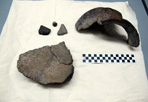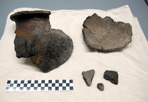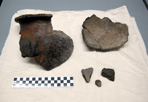
Initial Woodland
By: Caven Clark
he boundary between the Archaic and Wood land stages is archeologically defined by the introduction of ceramic technology. In eastern North America south of the boreal forest the first ceramic-producing cultures are referred to as Early Woodland, dating as early as 1000 BC. Early Woodland pottery is characteristically coil-constructed and thick, with cord-marked interiors and exteriors. By the time of the Middle Woodland cultural pattern, beginning about 300 B.C., ceramics had a wider variety of shapes, surface treatments, and types of decoration (Mason 1981). It was at this juncture that ceramics made their appearance in the material culture of the Shield Archaic (Wright 1972b), or were brought into the region around and north of Lake Superior by a different culture to the south (Buchner 1979).
In either event, the result in taxonomic terms was the transformation of the resident Archaic population into the Woodland stage, albeit with little or no change in subsistence practices. This echoes an earlier sentiment of Wright (1968:47) that, "The evidence from the sites under consideration . . . strongly suggests that ceramics are not an indigenous part of Ojibwa material culture." Mason (1981:286) summarizes the ambivalence with which he believes pots were accepted in the north:
There is a high probability that there were some people in the Laurel country who did not manufacture or use earthenware but who were fully contemporaneous with those who did and that the only empirical difference between their respective sites would be the presence or absence of sherds.In practice, there is synonymy in the terms "Initial Woodland" and "Laurel" in the Lake Superior basin. Other Initial and Early Woodland archeological cultures (e.g., Saugeen) are peripheral to this analysis, although as marginal manifestations of more southerly Woodland stage cultural evolution they represent analogous cultural developments (Mason 1981). The Laurel focus was defined by Wilford (1941) from his work in northern Minnesota. The definition was subsequently expanded into southern Manitoba by MacNeish (1958). Laurel sites are now known from a large area north of the Great Lakes and between Saskatchewan and central Quebec.
Other than the apparent deletion of large cop per artifacts from the tool inventory and a shift in lithic raw material preferences, there were no fundamental changes in the lithic and copper technology and their products from previous Archaic material culture. Net sinkers appear to be new in the region at this time (Wright 1967), and trade items such as Saugeen pottery, shell from Manitoba, and Yellowstone obsidian occur on both sides of Lake Superior (Janzen 1968; Wright 1967). There is a proliferation of small endscrapers in the Laurel culture, which is attributed to the functional needs of an economy devoted to fishing (Janzen 1968). Copper tools and ornaments in Laurel assemblages include the typical range of small forms common throughout prehistory. There are no copper tools or ornaments that are considered distinctively Laurel in style. It is assumed that copper was one of the items used by the Laurel people in the context of gift exchange or trade in the acquisition of nonlocal commodities. The degree of interregional exchange appears not to be too great, however, since nonlocal items rarely occur in appreciable numbers.
It is Laurel pottery that identifies this culture. Vessels were constructed by coiling and there was a modest use of temper. Vessels are hard and thin-walled, usually conoidal with straight rims and squared lips. Decoration, made by dentate stamping, linear stamping, push- pull, incising, pseudo-scallop shell impression, and use of punctates and bosses, was confined to the upper 1/2 to 1/3 of the vessel, which is otherwise smooth. Cord-marked exteriors and the use of cord-wrapped sticks (CWS) for decoration do not occur in Laurel assemblages (Mason 1981).
A provisional seriational sequence for Laurel ceramics begins with the Pike Bay phase in which most decoration is by linear stamp and push-pull (Mason 1981:289ff). In the McKinstry phase most decoration is with pseudo-scallop shell (PSS) impressions which, to many, is the hallmark of Laurel pottery. Finally, in the Smith phase, there is a return to the decorative styles that were popular in the Pike Bay phase. In addition to this chronological dimension there is a geographical distribution of design elements that underscores the internal variation within the Laurel culture; PSS has a higher frequency on northern sites, while the linear stamped and push-pull decorations are more common at sites along the southern border of the Laurel range. Similarities among Laurel ceramics and contemporaneous North Bay (Mason 1967, 1969, 1991), Saugeen (Wright 1967), and Point Peninsula (Stoltman 1973; Wright 1967) styles have been noted.
Also along the southern periphery are the largest Laurel sites and the only Laurel sites with burial mounds, principally along the Rainy, Nipigon, and Pigeon rivers near the international border. At the Smith Mound in northern Minnesota the mode of interment was by bundle burial in small ossuaries. There was also evidence for preburial ritual treatment in the form of dismemberment and defleshing (Mason 1981).
Archaeological Survey, 2013
Citations
- Buchner, A.P. 1979. The Shield Archaic: A Review. Manitoba Archaeological Quarterly 3(2):2-11.
- Clark, Caven P. Archeological Survey and Testing at Isle Royale National Park, 1987-1990 Seasons. Lincoln, Neb: U.S. National Park Service, Midwest Archeological Center, 1995. Print.
- Janzen, Donald E. 1968. The Naomikong Point Site and the Dimensions of Laurel in the Lake Superior Basin. Anthropological Papers No. 36. Museum of Anthropology, The University of Michigan, Ann Arbor.
- MacNeish, R.S. 1958. An Introduction to the Archaeology of Southwest Manitoba. Bulletin No. 157. Anthropological Series No. 44. National Museums of Canada. The Queens Printer, Ottawa.
- Mason, Ronald J. 1967. The North Bay Component at the Porte des Mortes Site, Door County, Wisconsin. The Wisconsin Archeologist 48(4):267-345.
- Mason, Ronald J. 1969. Laurel and North Bay: Diffusional Networks in the Upper Great Lakes. American Antiquity 34(3):295-302.
- Mason, Ronald J. 1981. Great Lakes Archaeology. Academic Press, New York.
- Mason, Ronald J. 1991. Rock Island and the Laurel Cultural Frontier in Northern Lake Michigan. Midcontinental Journal of Archaeology 16(1):119-155.
- Stoltman, James B. 1973. The Laurel Culture in Minnesota. Minnesota Prehistoric Archaeological Series No. 8. Minnesota Historical Society, St. Paul.
- Wilford, Lloyd A. 1941. A Tentative Classification of the Prehistoric Cultures of Minnesota. American Antiquity 6(3):231-249.
- Wright, Gary. 1967. Some Aspects of Early and Mid-Seventeenth Century Exchange Networks in the Western Great Lakes. The Michigan Archaeologist 13 (4) : 18 1-197.
- Wright, J.V. 1968. The Michipicoten Site. National Museum of Canada Bulletin No. 224:l-85. The Queen's Printer, Ottawa.
- Wright, J.V. 1972b. The Shield Archaic. National Museums of Man Publications in Archaeology No. 3. National Museums of Canada, Ottawa.



